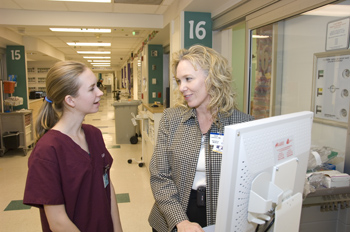When junior Mimi Wu signed up for the program in which undergraduates work in the St. Louis Children’s Hospital Emergency Department (ED), she thought each shift would resemble an episode of “Grey’s Anatomy.”
She didn’t expect that there would be slow times or that parents would rush their children to the ED simply because they had a runny nose or a virus.

And she still hasn’t bumped into McDreamy.
But the Pediatric Emergency Medicine Research Associates’ Program (PEMRAP), offered through BIO 265, has confirmed to Wu that she wants to become a physician.
“This is a great opportunity to get clinical experience, and it’s definitely helped me decide to go to medical school,” Wu said.
For eight hours each week, PEMRAP students, dressed in maroon scrubs, work shifts in the ED. On their own computerized board, they constantly scan patients for eligibility in clinical studies ranging from asthma to sickle cell disease to abdominal trauma.
If they see a patient who might be eligible, they introduce themselves to the family, explain the study and obtain informed consent from the parent. They also administer study questionnaires, occasionally videotape interviews and help the family complete other study requirements.
“PEMRAP enables these students to become an integral and valued part of the health-care team,” said Jan D. Luhmann, M.D., an assistant professor of pediatrics and a PEMRAP co-director who started the program in 2002. “Not only do they learn about clinical research, but they also have the opportunity to see first-hand how physicians and nurses work in a busy clinical setting. When not enrolling patients into one of the many clinical trials, students observe emergency procedures such as suturing or fracture reductions. The combination of clinical research and exposure to pediatric emergency medicine provides a unique opportunity.”
PEMRAP students also attend two hours of lecture each week to learn about clinical research. They also prepare a presentation about a medical topic they choose.
Since PEMRAP’s inception, students have enrolled more than 3,000 subjects in 18 clinical studies.
“Both the students and the principal investigators of these studies benefit,” said Kristine G. Williams, M.D., an assistant professor of pediatrics and the other PEMRAP co-director. “When the PEMRAP students aren’t in the ED, we notice a drop in the number of patients enrolled in studies.”
Students can enroll in BIO 265 for credit for only one semester. However, more than 80 percent of students continue in PEMRAP as volunteers, Luhmann said. The volunteer requirements are less stringent — they only work four hours a week and don’t have to attend lectures.
Many PEMRAP students decide to pursue medicine, and Williams and Luhmann often get notes from students in medical school, thanking them for the PEMRAP experience and telling them how valuable it was.
Junior Averi Leahy, another PEMRAP student, said she plans to pursue biological research in graduate school.
“But PEMRAP has given me a much better understanding of what it’s like to work in a hospital,” she said. “It’s also made me realize that the role of a doctor is to diagnose and treat but also to provide reassurance. A great doctor really connects with his or her patients.”
For Luhmann and Williams, mentoring the PEMRAP students has many merits.
“They enroll in the course with a lot of unfamiliarity about pediatrics, clinical research and communicating with patients and health-care professionals,” Luhmann said. “Yet in a short time, they’re interacting with families, nurses and physicians and have become competent research associates in the pediatric emergency department. For us, the greatest reward is seeing the enthusiasm the students gain for both clinical research and becoming a physician.”